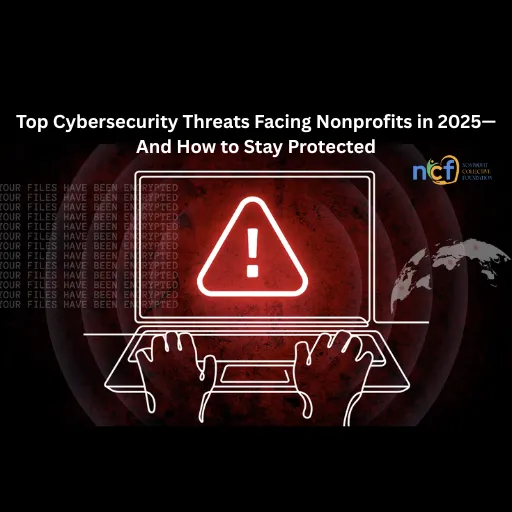
Top Cybersecurity Threats Facing Nonprofits in 2025—And How to Stay Protected
Top Cybersecurity Threats Facing Nonprofits in 2025—And How to Stay Protected
As digital transformation accelerates across all sectors, nonprofit organizations are becoming prime targets for cybersecurity threats. Despite their vital role in society, many nonprofits operate with limited budgets, outdated systems, and small IT teams — making them vulnerable to attacks that can compromise sensitive donor data and disrupt operations.
If you're searching for how to protect nonprofits from cyber attacks or want to learn the most common cybersecurity threats to nonprofits, this guide breaks it all down.

1. Phishing Scams: Still the #1 Threat
Phishing remains one of the most common cyber threats for nonprofits. These attacks trick staff or volunteers into clicking malicious links or entering credentials on fake login pages. Often disguised as donation requests or vendor invoices, these scams can lead to major data breaches.
Solution: Train all staff and volunteers with cybersecurity awareness training for nonprofits, and use email filtering tools to block suspicious messages.

2. Ransomware Attacks on Nonprofits
Ransomware — malware that locks access to data until a ransom is paid — has increased dramatically. Cybercriminals know that many nonprofits lack proper backups or recovery plans, making them more likely to pay.
Solution: Implement automated data backups and use cloud-based services with built-in security features. Ensure all systems are updated regularly.
3. Weak Passwords & Lack of Multi-Factor Authentication
Many nonprofits still use shared accounts with weak passwords or avoid enabling multi-factor authentication (MFA), which gives hackers easy access.
Solution: Use strong, unique passwords for every login, require MFA across all platforms, and consider a password manager to safely store credentials.
4. Outdated Software and Systems
Running old software exposes nonprofits to unpatched vulnerabilities. Legacy systems often lack modern security protocols and are incompatible with newer cybersecurity tools.
Solution: Regularly audit your systems. Consider affordable nonprofit tech grants for upgrades and explore discounted software through programs like TechSoup.
5. Insider Threats and Human Error
Not all threats come from outside. Untrained staff, disgruntled former employees, or simple mistakes can expose sensitive information or systems.
Solution: Limit access to sensitive data, track user activity, and provide ongoing security education.
Conclusion: Proactive Cybersecurity = Long-Term Trust
In today’s digital world, nonprofit cybersecurity is not optional — it's essential. By addressing these threats head-on with affordable, scalable solutions, nonprofits can protect donor trust and ensure mission continuity.
If you're unsure where to start, consider a free cybersecurity audit for nonprofit organizations or consult a trusted IT provider with experience in the nonprofit sector.
